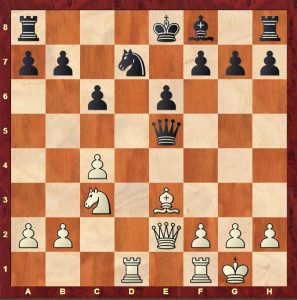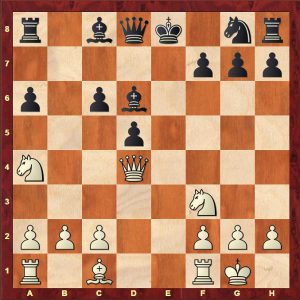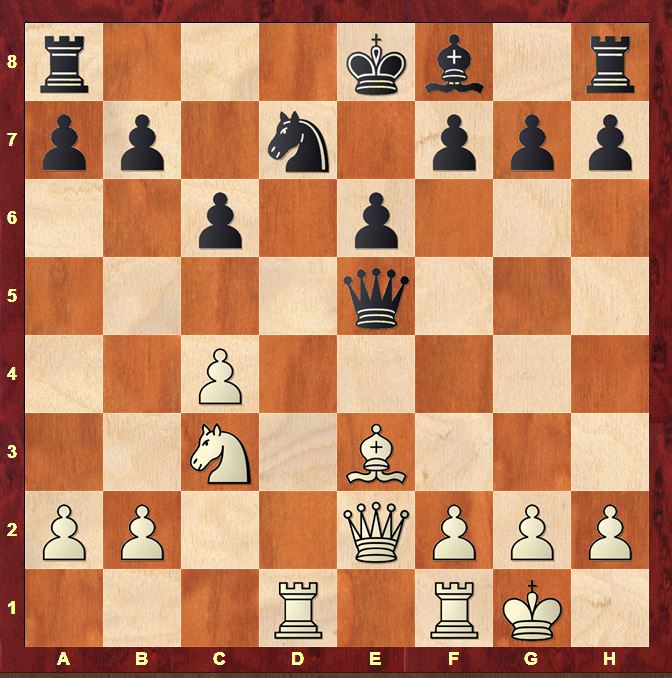I’ve spent a bit of time recently taking a look at Alekhine’s opening repertoire. 3 things struck me in particular. First of all, Alekhine played gambits until the end of his life, even against the strongest players in the world. Some examples:
1.e4 e5 2.d4 exd4 3.c3
was a regular guest in Alekhine’s early years. The game Alekhine-Isakov featured in my earlier blog article Attacking with Alekhine arose from this opening. Even late in his life, Alekhine regularly wheeled it out successfully in simultaneous displays. To give you an impression: in Alekhine’s 18 games in the database with this opening, he scores 15,5/18.
1.e4 c6 2.d4 d5 3.Nc3 dxe4 4.Nxe4 Nf6 5.Bd3
as in Alekhine’s attacking game against Winter at Hastings 1936/7. Alekhine also played 4…Bf5 5.Bd3 in 3 games (of which in 2 simultaneous displays) Only 1 person dared take the d4 pawn against him!
1.e4 e6 2.d4 d5 3.Nc3 Bb4 4.Bd2 dxe4 5.Nxe4
was only ventured once by Alekhine, but look at the opponent: Salo Flohr at Nottingham 1936! At that time, Flohr was seen as a potential World Champion. Equally impressive was Alekhine’s game against another of the world’s strongest players of that time: Samuel Reshevsky at Kemeri 1937:
1.e4 Nf6 2.e5 Nd5 3.d4 d6 4.c4 Nb6 5.Nf3 Bg4 6.Be2 dxe5 7.Nxe5 Bxe2 8.Qxe2.
The second thing that struck me was that Alekhine used gambits to clear the centre of pawns. All the lines above happily jettison the d-pawn, trusting in compensation through the rapid development of pieces and the use of the lines and diagonals that an open centre provides. With that in mind, it was interesting to compare Alekhine’s play in the Sicilian Wing Gambit:
1.e4 c5 2.b4 cxb4
Here the aim of the gambit is to establish a strong pawn centre by diverting Black’s control of d4 (via the c5 pawn) at the cost of a pawn. It’s a completely different aim…and look how horribly Alekhine handled it! A couple of examples:
1.e4 c5 2.b4 cxb4 3.d4 d5 4.e5 Nc6 5.a3 Qb6 6.Be3 Bf5 7.Nf3 e6 8.a4 Rc8 9.Be2 Nge7 10.Nbd2 Na5 11.Bb5+ Nec6 12.0–0 a6 13.Bd3 Bxd3 14.cxd3
was pretty disgusting for White in Alekhine,A-Konjovic,N Sombor 1930 (simultaneous) although Alekhine managed to win
1.e4 c5 2.b4 cxb4 3.d4 d5 4.e5 Nc6 5.Be3 g6 6.Ne2 Bh6 7.Qd2 Bxe3 8.Qxe3 Bf5 9.Qd2 Qb6 10.c3 e6 11.f3 Rc8 12.Qe3 h5 13.g3 bxc3 14.Nbxc3 Nb4 15.Kf2 Nc2 16.Qc1 Nxa1 17.Qxa1
was even worse in Alekhine,A-Surber Surabaya 1933 (simultaneous). There’s certainly nothing in Alekhine’s handling of the Wing Gambit that would make you want to copy him!
Thirdly, I also noticed a related category of gambits – especially with Black – where given the presence of an open centre, Alekhine was willing to offer up a wing pawn (most often a g-pawn) in order to gain time for rapid development.
In this article, I’d like to take a deeper look at 2 “gambit moments” from Alekhine’s games. The first focuses on a crucial stage in the Alekhine-Reshevsky game at Kemeri 1937 mentioned earlier in which White offers up a central pawn for compensation that I found very difficult to believe! The second features the game Rabinovich-Alekhine Russian Championship 1912 in which Alekhine as Black offers his g7 pawn in order to recover his disadvantage in development in an open position.

This position was reached after Black’s 13th move. Black lags a little behind in development, but his position seems solid enough. Alekhine finds an excellent way of exerting fresh pressure on the Black position.
Alekhine,Alexander – Reshevsky,Samuel
Kemeri 1937
14.Qf3
With one move, Alekhine turns Rxd7 into a concrete threat and introduces the idea of Bf4 (inconveniencing the Black queen) Bd4 (particularly annoying if Black tries to develop with …Be7) or Rfe1 threatening a discovered attack on the exposed Black queen. The queen also supports Ne4, eyeing the weak d6 square. As if that wasn’t enough for one move, another idea also becomes possible… and that’s one I missed completely when analysing!
14…Be7
is the move I wanted to play. Reshevsky elected to return the a-pawn with 14…0–0–0 when White had a pleasant advantage after 15.Bxa7 Qa5 16.Bd4 Qf5 17.Qg3. 14…Bd6 is simply met by 15.g3
I now analysed 3 possibilities:
1. 15.Rxd7 is not Alekhine’s finest piece of analysis 15…Kxd7 16.Qxf7 Qf6 or Rae8 both win easily for Black. Also a bit shocking that Panov and Kotov quote this without comment!
2. 15.Bd4 Qg5 (15…Qf5 16.Qxf5 exf5 17.Bxg7 is just a nice edge for White) 16.Ne4 Qg6 17.Rfe1 was a line on which I spent a lot of time. It’s quite a typical practical scenario: White isn’t exactly at Black’s throat, but his activity is difficult to manage away. Take a look at the following variations I came up with.
a) 17…Nf6 Black tries to exchange off the dangerous White knight and prepares kingside castling as his own knight is no longer loose on d7 18.Nc5 0–0–0 19.Nxb7 (19.Qa3 was my line 19…Nd7 (19…Bxc5 20.Qxc5; 19…Kb8 20.Na6+; 19…a6 20.Qa5 with the idea of Be5) 20.b4 Bxc5 21.bxc5 is very dangerous for Black according to Stockfish) 19…Kxb7 20.Qb3+ Ka8 (20…Kc8 21.Qa4) 21.Qa4 Rxd4 22.Qxc6+ Kb8 23.Qb5+ Kc8 24.Rxd4 is Stockfish’s line which also looks very pleasant for White.
b) 17…a6 Preparing queenside castling by placing the a-pawn on a protected square 18.Bc3 0–0–0 19.Qe3 Nf6 20.Rxd8+ Rxd8 21.Ba5 with the idea of Qa7 is Stockfish’s line;
c) 17…Nb6 18.Bxb6 (18.Qb3 0–0–0) 18…axb6 19.Qb3 is a little edge for White as Black’s queenside is vulnerable without the queen to protect it.;
d) 17…e5
This is Black’s most ambitious move, and also the area I focused on the most.
18.Ng3
fighting against Black’s idea with tactical means
d1) 18…exd4 19.Nf5;
d2) 18…0–0 19.Nf5 Bf6 20.Bc3 Rad8 21.Bb4 c5 22.Bc3 is pleasant for White according to Stockfish: Black’s queenside is again missing the presence of the Black queen!;
d3) 18…f6 19.Nf5 Qf7 20.Qb3 Again looking to exploit the weakened queenside (20.Qg4 g6 21.Nh6 Qg7 22.Bxa7 was my idea 22…Bf8 23.Be3 f5 24.Qg5 Qxh6 25.Qxh6 Bxh6 26.Bxh6 0–0–0 is Black’s safest) 20…b6 21.Be3 g6 22.Nxe7 Qxe7 23.Qa4 is a nice advantage for White according to Stockfish 23…Qe6 24.Rd2 0–0 25.Red1
d4) 18…Qe6 is the main move.
19.Nf5 0–0 20.Qg4 g6 (20…Qf6 21.Bc3; 20…Bf6 21.Bc3) 21.Bc3 Kh8 22.Nh6 f5 23.Qd4
I was very proud of myself for finding this total concept while walking to work in the morning! It doesn’t win however, though it gets close! 23…exd4 (23…Rad8 24.Rxe5 Nxe5 25.Qxe5+ Bf6 (25…Qxe5 26.Bxe5+ Bf6 27.Rxd8; 25…Qf6 26.Qxf6+ Rxf6 27.Bxf6+ Bxf6 28.Nf7+) 26.Qxf6+ Rxf6 27.Rxd8+ Kg7 28.Ng8 wins!) 24.Rxe6 dxc3 25.Rxe7 c2 (25…cxb2 26.Rexd7) 26.Rc1 Rad8 27.Rxc2 (27.Nf7+ Rxf7 28.Rxf7 Ne5) 27…Nc5 28.f3 Rfe8 is only equality!;
e) 17…0–0–0 18.Bxa7 Ne5 19.Qe2 Rxd1 20.Rxd1 Rd8 is Stockfish’s equaliser and Black’s best in this position.
White however has a much stronger continuation in this position which I’d completely missed. Really careless because Alekhine mentioned the idea against 14…Nf6 in his notes!
15.Nb5
15…cxb5
15…Rd8 16.Bd4
16.Rxd7
16.Qxb7 Rd8
16…Kxd7 17.Qxb7+ Qc7 18.Rd1+ Bd6 19.Rxd6+ Kxd6 20.Bf4+ wins!
15.Nb5 is thus the additional hidden threat introduced by 14.Qf3! Wonderful feel for the initiative from Alekhine!
1–0
And now the second example:

Rabinovich,Abram – Alekhine,Alexander
RUS-ch 1912
11…Ne7
A typical Alekhine choice, giving up the g-pawn for development gain and for an open line against the White king
12.Qxg7
12.Bh6 Nf5 13.Qc3 (13.Rfe1+ Be6) 13…0–0 14.Qxc6 Bd7 15.Qxd5 Be6 wins a piece
12…Rg8 13.Qc3
13.Qf6 An annoying move and the source of a typical practical dilemma you face when playing such sacrifices against weaker players. Do you have anything better than a repetition if White plays 13.Qf6? 13…Rg6 14.Qh8+ Rg8
13.Qxh7 Bf5 14.Qh6 is given by the computer, but in a practical game, Black has reasonable chances
13…Bh3
14.Nh4
14.Bg5 is simpler. 14…h6 15.gxh3 hxg5 16.Rae1 with a good game for White.
The position is now quite picturesque with both knights side-lined on a4 and h4. Black now begins to use clever tactics to develop the pace of his attack with combined threats against the White king and the 2 offside knights. This is where I started analysing.
14…Qd7
A lovely move, positively inviting White to exploit his knight on a4!
15.Re1
Preventing Black’s queen from getting closer to the White king by tactical means
15.Nb6 Rxg2+ (15…Bxg2 16.Nxg2 Qg4 wins too) 16.Nxg2 Qg4
15.Kh1 Bxg2+ 16.Nxg2 Qg4 17.Rg1 Qxa4 is given by Kotov. Strangely enough, the computer gives White a slight advantage after 18.Re1! as 18…Qg4 loses to 19.Qxc6+
15…Rb8
15…Rxg2+ 16.Nxg2 Qg4 17.Qxc6+ Kf8 18.Bh6+ Kg8 19.Qxa8+ winning is the point of Re1
The text prepares …Rxg2 as the rook on a8 is no longer hanging after Qxc6+. The text seems to gain a tempo due to the threat of …Bb4. This is illusory however as …Bb4 can always be met by Qe5. …Rb4 is however a very annoying threat.
Now White has a difficult choice to make.
1. 16.Qf6 The choice in the game. It’s an attempt to deal with the threat of …Rxg2+ and …Qg4 but now Black homes in on the 4th rank and the 2 juicy knights hanging on it.
16…Rb4
16…Rxg2+ 17.Nxg2 Qg4 18.Qg5 was White’s idea
17.Bg5
17.Nc3 Rxh4 18.Qxh4 Rxg2+ 19.Kh1 Rxh2+ 20.Kg1 Rg2+ 21.Kh1 Rg4
17…Rxa4
Black was easily winning although the tactics lasted for a little while longer
18.f4 Bg4 19.h3 Bxh3 20.b3 Re4 21.Rxe4 dxe4 22.Re1 Qe6 23.Qc3 Bf5 24.Bxe7 Kxe7 25.Qxc6 Bxf4 26.Qc5+ Kf6 27.Rf1 Qe5 28.Qf2 Rg4 29.Kh1 e3 30.Qe1 Bg3 31.Nxf5 Bxe1 32.Nxe3+ Kg5
0–1
2. 16.Re3 d4 Ouch!
3. 16.Bd2 Rxg2+ (16…Rb4 17.Qxb4 was the idea of 16.Bd2, but even this doesn’t seem to work! 17…Bxg2 18.Nxg2 Bxb4 19.Bxb4 Qg4 20.Rxe7+ Kd8) 17.Nxg2 Qg4
18.Rxe7+ (18.Qh8+ Kd7 19.Rxe7+ Bxe7; 18.Qxc6+ Kf8 19.Bh6+ Kg8) 18…Kxe7 19.Qe3+ Kd7 20.Qa7+ (20.Qg5 Rg8) 20…Kd8 21.Ba5+ Ke8 22.Qe3+ Kf8 23.Qh6+ Kg8;
4. 16.Nc5 Qg4 (16…Bxc5 17.Qxc5) 17.Qf6 A very interesting idea that leads to a draw in 2 ways:
a) 17…Qxh4 18.Qxd6;
b) 17…Bxc5 18.Qxc6+ Kd8 19.Qxc5 Qxh4 20.Qd6+ Kc8 21.Bf4 wins (21.Qxe7 Rxg2+ 22.Kh1 Rg1+; 21.Rxe7 Rxg2+ 22.Kh1 Rg1+ 23.Kxg1 Qg4+ 24.Qg3 Qd1+) ;
c) 17…Bxg2
c1) 18.Bf4 Be4+ 19.Bg3 Bxc5;
c2) 18.Rxe7+ Bxe7 19.Qxc6+ Kd8 (19…Kf8 20.Bh6+) 20.Bf4 Be4+ 21.Bg3 Qc8 holds!
c3) 18.Qxd6 Be4+ (18…Bf3+ 19.Qg3 Qxh4 20.Qxg8#) 19.Kf1 I didn’t realise this was possible! (19.Qg3 Qxh4)
And now the 2 drawing lines:
d) 17…Rg6 18.Qh8+ Rg8 19.Qf6 is a draw by repetition (pointed out by Stockfish of course!)
e) 17…Qxg2+18.Nxg2 Rxg2+ 19.Kh1 Rxh2+ 20.Kg1 Rg2+ draws
5. 16.Bg5 looked the best to me and this is also Komodo’s choice 16…d4 (16…Rxg5 17.Qh8+; 16…h6 17.Bxe7 Bxe7 18.Nc5) 17.Qd2 (17.Bxe7 dxc3 18.Bxd6+ Be6 19.Bxb8 is Stockfish’s line 19…Qd4 20.Nxc3 Qxh4 21.Rad1)
a) 17…Rb5 18.f4;
b) 17…f6 18.Bxf6 Bxg2 19.Nxg2 Qh3 (19…Rxg2+ 20.Kxg2 Qg4+ 21.Kf1 Qh3+ 22.Ke2 Qe6+ 23.Kd1 Qxf6 24.a3) 20.f4 Bxf4 21.Rxe7+ Kf8 22.Bg7+
22…Kxe7 23.Qxf4 wins;
c)17…Qg418.f4 Rxg5 19.fxg5 Qxh4 20.gxh3 Rb5 21.Kh1 is Komodo’s main line which is not 100% convincing though White does seem to stand better.
Just as a comparison, another Alekhine sacrifice of a g-pawn as Black in an open centre:
Grigoriev,Nikolay Dmitrievich – Alekhine,Alexander
Moscow m 1919
1.e4 e5 2.Nf3 Nc6 3.Bb5 Nf6 4.0–0 Nxe4 5.Qe2 Nd6 6.Bxc6 dxc6 7.Qxe5+
7…Be7 8.Qxg7 Bf6 9.Qh6 Be6 10.d3 Rg8 11.Re1 Qe7 12.Nbd2 Rg6 13.Qf4 0–0–0
14.Nb3 Nf5 15.g3 h5 16.Ne5 Bxe5 17.Rxe5 Nh4 18.Nc5 Rd5 19.Rxd5 Bxd5 20.Ne4 Rg4 21.Qh6 Rxe4
0–1



